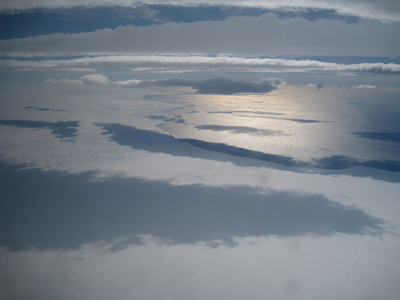Ice-penetrating radar being towed across Ferrigno Ice Stream on 8 January 2010. Image by glaciologist Dr Robert Bingham
British scientists say they have found a mile-deep rift valley hidden beneath the West Antarctic Ice Sheet – think the scale of the Grand Canyon. They believe that this hidden gash is contributing to a speeding up of ice melt and, thus, rising sea levels in this part of the continent.
The scientists, who hail from the University of Aberdeen and the British Antarctic Survey, published their findings in Nature this week.
They said they made the discovery of the deep chasm below Ferrigno Ice Stream, a remote Antarctic region that was apparently only ever visited once before in 1961.
Dr Robert Bingham, a glaciologist working in the University of Aberdeen’s School of Geosciences, and lead author of the study, said he discovered the rift while he was carrying out three months of fieldwork with the British Antarctic Survey in 2010.

The ice margin of Ferrigno Ice Stream where it flows into Eltanin Bay. Image by glaciologist Dr Robert Bingham
Right now, scientists are closely monitoring the West Antarctic Ice Sheet as it is apparently losing ice faster than any other part of Antarctica, with some glaciers supposedly shrinking by more than one metre per year.
For the past 20 years, scientists have been using satellites to monitor ice losses from Antarctica.
“We have witnessed consistent and substantial ice losses from around much of its coastline. For some of the glaciers, including Ferrigno Ice Stream, the losses are especially pronounced, and, to understand why, we needed to acquire data about conditions beneath the ice surface,” said Bingham.
During their research, the team gathered data using an ice-penetrating radar system towed behind a skidoo. This was driven across the relatively flat ice surface, over a distance of 2,414 kilometres.
“What we found is that lying beneath the ice there is a large valley, parts of which are approximately a mile deeper than the surrounding landscape.
‘Huge rift valley’
“If you stripped away all of the ice here today, you’d see a feature every bit as dramatic as the huge rift valleys you see in Africa and in size as significant as the Grand Canyon,” said Bingham.
This massive rift was “at odds” with the flat ice surface that the scientists were driving across, said Bingham. He said that without these measurements the team would never have known it was there.
“What’s particularly important is that this spectacular valley aligns perfectly with the recordings of ice-surface lowering and ice loss that we have witnessed with satellite observations over this area for the last 20 years,” he added.
The British Antarctic Survey’s Prof David Vaughan, who leads Ice2sea, a EU-funded FP7 research programme to improve projections of global and regional sea levels, said that thinning ice in West Antarctica is contributing to nearly 10pc of global sea level rises.
“It’s important to understand this hot spot of change so we can make more accurate predictions for future sea-level rise,” added Vaughan.
Iceberg tear – Greenland
Earlier this month, we learned that an iceberg reportedly twice the size of Manhattan, New York, had torn away from Greenland’s Petermann glacier. The event was captured by NASA’s Aqua satellite in real-time between 16-17 July 2012.
“The Greenland ice sheet as a whole is shrinking, melting and reducing in size as the result of globally changing air and ocean temperatures and associated changes in circulation patterns in both the ocean and atmosphere,” said Andreas Muenchow, an associate professor of physical ocean science and engineering at the University of Delaware.